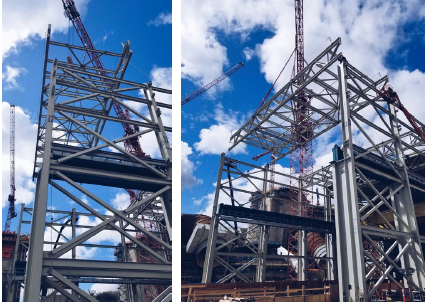Energy
Site C Clean Energy Project
Client: BC Hydro / / Contract Holder: AFDE Partnership
4,000
Tonnes (MT)
$25
Value ($M)
May 2018 – September 2021
Date
Steel Fabrication & Supply, Construction, Industrial Paint & Coating, Engineering & Drafting
Waiward Services
About Site C Clean Energy Project
Construction on site started in April of 2019 and would continue through to 2021. On March 2020, the global pandemic of COVID-19 was declared. The Site C Clean Energy project was shut down from March 18, 2020 to June 4, 2020.
Waiward Scope of Work
- Supply and install Powerhouse columns and wall steel
- Supply install and align crane rail system
- Assemble and install 300MT Overhead bridge crane
- Supply and install Powerhouse Roof truss and infill steel
- Supply and install of roof deck system
- Supply and install Operations Building steel, inclusive of 2 x stair towers
- Supply and install of floor and roof deck system
For the Powerhouse structure, we performed the following:
- Installation of sixty 11 Tonne support columns
- Installation of fifty 10 Tonne crane girders
- Installation and alignment of 454 meters of crane rail
- Preassembly and installation of nine 75 Tonne box truss assemblies

Optimizing Modular Assembly
as well as tensioning. This greatly reduced the amount of critical elevated work, which in addition to promoting efficiencies, it also allowed for a safer means of execution.
Additionally, the construction team identified a similar means to improved efficiency and safety by taking a similar approach to the constructability of the Operations Building. All floor and roof sections were also pre-assembled on the ground, which again reduced the work at elevation.
Creating Solutions
The observed challenges on this site have mainly related to shared resources (Tower Cranes) as well as a very congested
work site with respect to site layout and logistics. Essential coordination with other neighboring contractors, has been critical in order to establish and maintain overall project cohesiveness. Also, due to the unique dynamics of the site logistics, an internal coordinated effort to steam line fabrication and delivery sequences to avoid bottlenecking on site. Coupled with the challenges related to the COVID-19 pandemic, and associated site closures lent to unique challenges with regards to mitigating storage/demerge challenges. Through resequencing our shop loading, and getting client support with allocating additional storage space at site, we were able to help minimize the overall costs to the project.
